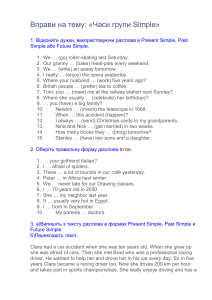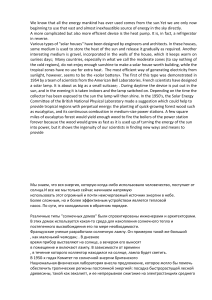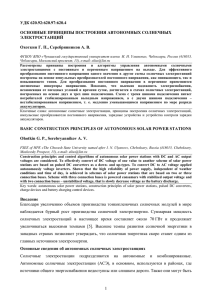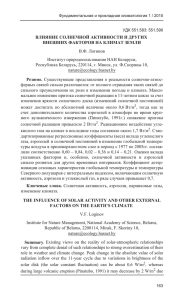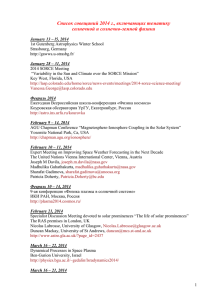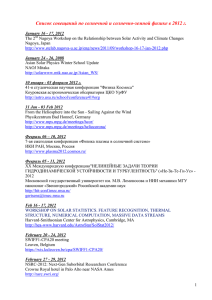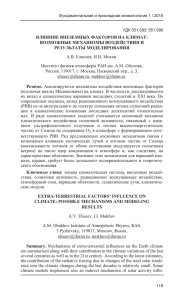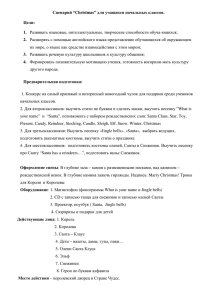
MECH/ENGR 372 Space Systems Design and Engineering II Power Systems Dr. Christopher Kitts Associate Professor, Santa Clara University Satellite Power Systems Required Functions – Generate power to support average demands of components – Store power to provide energy when arrays are not illuminated and during peaks – Condition, regulate, suppress transients, and convert power as required by components – Distribute power throughout spacecraft to components – Include some level of robustness to power-related faults – Include special functions such as safety inhibits, ordnance firing support, etc. Considerations – Degradation over mission life and variation (radiation, thermal cycling, etc.) – Orbit parameters (radiation, solar parameters, etc.) – Spacecraft configuration (spinner vs 3-axis control, mechanisms, etc.) Space Systems - Power: C. Kitts, Santa Clara University 2 Satellite Power Systems Power Generation Source Control Regulation & Control Storage Control Energy Storage Space Systems - Power: C. Kitts, Santa Clara University 3 Power Distribution Satellite Loads Satellite Power Systems Generation Options Photovoltaics RTGs Primary batteries Tethers Solar dynamic Nuclear reactor Power Generation Source Control Regulation & Control Storage Control Energy Storage Space Systems - Power: C. Kitts, Santa Clara University 4 Power Distribution Satellite Loads Satellite Power Systems Generation Options Photovoltaics RTGs Primary batteries Tethers Solar dynamic Nuclear reactor Power Generation Source Control Regulation & Control Storage Control Storage Options Secondary batteries Fuel Cells Flywheels Energy Storage Space Systems - Power: C. Kitts, Santa Clara University 5 Power Distribution Satellite Loads Satellite Power Systems Generation Options Photovoltaics RTGs Primary batteries Tethers Solar dynamic Nuclear reactor Power Generation Source Control Source Control Shunt Dissipation Series Dissipation Storage Options Secondary batteries Fuel Cells Flywheels Regulation & Control Peak power tracking Direct energy transfer Regulation & Control Power Distribution Storage Control Energy Storage Space Systems - Power: C. Kitts, Santa Clara University 6 Storage Control Charge Control Reconditioning Satellite Loads Satellite Power Systems Generation Options Photovoltaics RTGs Primary batteries Tethers Solar dynamic Nuclear reactor Power Generation Source Control Source Control Shunt Dissipation Series Dissipation Storage Options Secondary batteries Fuel Cells Flywheels Regulation & Control Peak power tracking Direct energy transfer Regulation & Control Distribution Cabling Switching Fault Protection Power Distribution Storage Control Energy Storage Space Systems - Power: C. Kitts, Santa Clara University 7 Storage Control Charge Control Reconditioning Satellite Loads Satellite Power Systems Generation Options Photovoltaics RTGs Primary batteries Tethers Solar dynamic Nuclear reactor Power Generation Source Control Source Control Shunt Dissipation Series Dissipation Storage Options Secondary batteries Fuel Cells Flywheels Distribution Cabling Switching Fault Protection Regulation & Control Peak power tracking Direct energy transfer Regulation & Control Storage Control Energy Storage Space Systems - Power: C. Kitts, Santa Clara University 8 Power Distribution Satellite Loads Demand Average & Peak Duty cycling Storage Control Charge Control Reconditioning Lecture Topics Generation (emphasis on photovoltaics) Storage (emphasis on batteries) Regulation & Control Distribution Systems Issues – Power budgeting – System interactions – Commands and telemetry – Fault Tolerance Space Systems - Power: C. Kitts, Santa Clara University 9 POWER GENERATION Space Systems - Power: C. Kitts, Santa Clara University 10 Power Generation Primary batteries – Chemical reaction produces energy (primary = not-rechargeable) – Launch vehicles, very short duration spacecraft (~hours to days) Photovoltaic cells – Photovoltaic effect in p-n junction semiconductors generates power Static thermal-to-electric – Heat source drives a thermal-to-electric energy conversion process – Sources: solar, radioisotope decay, nuclear fission reaction – Thermoelectric, thermionic Dynamic thermal-to-electric – Heat source and heat exchanger to drive an engine – Sources: solar, radioisotope decay, nuclear fission reaction – Cycles: Stirling, Rankine, or Brayton Space Systems - Power: C. Kitts, Santa Clara University 11 Power Generation Comparison Wertz, SMAD Space Systems - Power: C. Kitts, Santa Clara University 12 Power Generation Comparison Fortescue, Fig 10.1 Space Systems - Power: C. Kitts, Santa Clara University 13 POWER GENERATION Photovoltaics Space Systems - Power: C. Kitts, Santa Clara University 14 Solar Power - Introduction Illumination Photovoltaic effect Solar cell – Types – Performance Solar Arrays – Layouts – Performance – Practical Issues Solar Array Design Process EUVE, Courtesy UC Berkeley Space Systems - Power: C. Kitts, Santa Clara University 15 Solar Power – Solar Illumination Illumination a function of distance – 1358 W/m2 = Average solar power density at Earth-Sun distance outside of Earth’s atmosphere – Varies: ~ 1310 W/m2 at aphelion to 1400 W/m2 at perihelion – Solar intensity decreases w/square of distance to sun – so, can be much less for outer planetary probes (Venus~2600 W/m2, Mars~585 W/m2, Jupiter~50 W/m2) Time in eclipse (worst case approximation, circular polar orbit) RE −1 ρ = sin h + RE Max t eclipse = Where: ρ=Earth’s angular radius (deg) P=orbital period h=orbit altitude (km) RE=6378 km 2ρ P o 360 Sellers Fig 13-20 Space Systems - Power: C. Kitts, Santa Clara University 16 Solar Cell Theory: Semiconductors Semiconductor lattice (Silicon example): – Each atom shares 4 electrons within lattice to fill valance band with 8 electrons Si Si Si Si Si Si Si Si Si Si Si Si Si Si Si Si Si Si Si Si Si Si Si Si Si Si Si Si Kitts Space Systems - Power: C. Kitts, Santa Clara University 17 Solar Cell Theory: Semiconductors N-type doped semiconductor – creates extra electrons: – Pentavalent atoms (atoms w/5 electrons in valance band, like Antimony) added as impurities – Note – the lattice is still neutrally charged… it simply has mobile electrons in this form Si Si Si Si Si Sb Si Si Sb Si Si Si Si Si Si Si Si Si Si Si Si Si Si Si Sb Si Si Si Kitts Space Systems - Power: C. Kitts, Santa Clara University 18 Solar Cell Theory: Semiconductors P-type doped semiconductor – creates extra holes: – Trivalent atoms (atoms w/3 electrons in valance band, like Boron) added as impurities – Note – the lattice is still neutrally charged… it simply has mobile holes in this form Si Si Si Si Si B Si Si B Si Si Si Si Si Si Si Si Si Si Si Si Si Si Si B Si Si Si Kitts Space Systems - Power: C. Kitts, Santa Clara University 19 Solar Cell Theory: Semiconductors Create a P-N Junction – Electron diffusion across junction fills holes – Creates a “depletion region” where charge carriers don’t exist – Field in the depletion region inhibits additional flow of charge – Coulomb forces limit size of region P-type doping N-type doping p-type positive carriers n-type negative carriers Note: free hole carriers,but the material does NOT have a net positive charge Note: free electron carriers,but the material does NOT have a net negative charge P-N Junction - - For solar cells, the potential difference drives the photovoltaic power generation + + + + + + + Kitts Depletion region Extra electron - Negative ion Space Systems - Power: C. Kitts, Santa Clara University 20 Extra hole + Positive ion Solar Cell Theory: Photovoltaic Effect Simple model of the photovoltaic effect – – – – – Photon strikes cell and its energy moves an electron to the conduction band Electron-hole pair created and separated / driven by p-n potential difference – E field Electrons flow out n-type, through load, and recombine with hole at p-type Note: some electrons reflected by cell, some pass through cell Note: for absorbed photons, difference btw photon energy and gap energy becomes heat Energy (eV) Front contact N-type semiconductor E Field + Depletion region Electron travel - LOAD Conduction band Band Gap Energy Valence band Thermal energy or energy from a photon can create an electron-hole pair by moving the electron from the valence band to the conduction band P-type semiconductor Rear contact Kitts Space Systems - Power: C. Kitts, Santa Clara University 21 To help protect y our priv acy , PowerPoint prev ented this external picture from being automatically downloaded. To download and display this picture, click Options in the Message Bar, and then click Enable external content. Solar Cells Typical layered architecture for a solar cell – N and P layers (usually thin N layer on top of thicker P layer) Electrons (minority carriers in P layers) have much longer diffusion length than holes in N layers; since radiation damages cells by reducing effective diffusion paths, a P base layer is less susceptible to damage – BSR (back surface layer) used on back to reflect photons back through – Electrical contact layers (top one is windowed to allow light to pass through) Top layer contact trade-off: Cover it all and light can’t pass through. Cover only at the edges and electrons have to travel far to get to contact. But there is “series resistance” within the semiconductor, so want to limit this since it is a source of losses. – Antireflective coating on top used to prevent reflections – Cover glass – hermetic seal used for structural, thermal, radiation protection Often smooth for pointed panels but textured if not actively pointed in order to increase photon capture Clear Coverglass Antireflective Coating Front Electrical Contact N-doped Si P-doped Si Kitts Back Surface Reflector Back Electrical Contact Space Systems - Power: C. Kitts, Santa Clara University Example: Plastecs 22 Additional types of solar cells Si semiconductor lattice – Si atoms share 4 electrons to fill valence band w/8 electrons – Ge (Germanium) can do the same Apapted from Honsberg & Bowden, Photovoltaics Other possibilities – element combinations with 3+5 or 2+6 valence electrons – III-V: Ga+As (Gallium Arsenide), Ga+P (Gallium Phosphide), etc. – II-VI: Cd+S (Cadmium Sulfide), Cd+Te (Cadmium Teluride), etc. Different combinations of elements lead to differences in: – – – – Energy conversion efficiency Ease of manufacturing Radiation tolerance Structural integrity Space Systems - Power: C. Kitts, Santa Clara University 23 Cell Efficiency photons is converted to electricity An incident photon must transfer an amount of energy equal to the band gap energy in order to generate an electron-hole pair – Photons with energy below this level are lost – Photons with energy above this level are converted, but excess energy is lost – Note that photon energy is a function of frequency (wavelength) Different semiconductor lattice structures have different band gap energies, thereby leading to different efficiencies What is the “most efficient” band gap energy – Too high and lower energy photons lost – Too low and excess photon energy lost – Given photon energies in the solar spectrum, empirical estimate ~1.4 eV (single layer cells) Energy (eV) Only a portion of the energy of incident Conduction band Band Gap Energy Valence band If EPho<EBG, no electron-hole generation If EPho=EBG, an electronhole pair is generated If EPho>EBG, an electronhole pair is generated and the photon continues with EPho_new=Epho_orig-EBG Thermal energy or energy from a photon can create an electron-hole pair by moving the electron from the valence band to the conduction band Cell Material Band Gap (eV) Max Wavelength (µ µm) Silicon 1.12 1.12 CdS 1.2 1.03 GaAs 1.35 0.92 GaP 2.24 0.56 CdTe 2.1 0.59 CuGaInSe2 1.0 1.24 Extended from Fortescue Table 10.1 Space Systems - Power: C. Kitts, Santa Clara University 24 Comparison of Cell Types (Single Layer) Note: quoted numbers are often for lab quality cells tested under ideal conditions Silicon: production cells ~ 15%, lab cells ~24% – Crystalline silicon (example used in previous discussions), inexpensive, rugged – Polycrystalline silicon & amorphous silicon: cheaper but less efficient (5-10%) Gallium-Arsenide: production cell ~19%, lab cells ~22% – Larger band gap energy (high efficiency) and less susceptible to radiation (2-3 x) than Si – More expensive material & doping process; also brittle (difficult to manufacture) – Ultimately, manufacturing solution is to put on layer of germanium Indium Phosphide: production cells ~18%, lab cells ~20% – Outstanding radiation tolerance (more than an order of magnitude better than Si) Cadmium Telluride: lab thin films ~17% – Thin films use less material, allow flexibility, and have potential to be less expensive Copper Indium Diselenide: lab thin films ~20% Space Systems - Power: C. Kitts, Santa Clara University 25 Solar Cell Efficiency Space Systems - Power: C. Kitts, Santa Clara University 26 Multi-layer (multi-junction) Cells Improved efficiency with integrated “stacks” of cells – “multi-junction” – Highest band gap junction on top so highest energy photons absorbed first – Each junction is sensitive to different parts of the solar spectrum – Junctions connected in series – higher voltage with less relative current density Dual Junction Example - (see figure) – ~21-24% production cells – GaAs (Gallium Arsenide) with GaInP2 (Gallium Indium Phosphide) on top Sandia Triple Junction Example – – ~28%+ production cells – Dual junction GaAs and GaInP – 3rd junction: activating the interface with the germanium substrate on the bottom Pisacane Fig 6.10 Space Systems - Power: C. Kitts, Santa Clara University 27 Solar Cell Power Generation Electrical model of a solar cell extends the concept of a diode Diode review Forward bias Once external voltage is high enough, it overcomes internal field and pulls n-region electrons through the depletion region I (conventional current) Reverse bias External voltage pulls n-region electrons away from the depletion region, inhibiting current flow V-I Curve Characterization of performance: small forward bias enables current flow; no negative current flow until large negative breakdown is reached no conventional current I + p p - - + V -------+++++ - free electrons pulled through V -------+++++ n n electron flow -10’sV + no electron flow Space Systems - Power: C. Kitts, Santa Clara University 28 free electrons pulled away Not to scale ~0.5V V Solar Cell Power Generation Solar cell model: superposition of a diode and the photovoltaic effect qV nkT I = I O e − 1 I V-I curve shifts down with increased illumination. Interpretation is that light creates a forward voltage bias combined with a negative current flow, meaning that the device supplies current rather than consumes current V qV nkT I = I O e − 1 − I L + - Simplified model neglecting internal resistance I qV nkT I = I L − I O e − 1 Where: I=device current Io=device leakage current in dark q=||electron charge|| V=device voltage k=Boltzmann’s constant T=absolute temperature IL=Light generated current n = measure of how ideal device is (n=1 is ideal; 1<n<2) Space Systems - Power: C. Kitts, Santa Clara University 29 V As a convention, the V-I curve is typically inverted with the understanding that power is now being generated when cell is illuminated Solar Cell Power Generation Solar cell operation ISC VL, IL I ISC (short circuit current): Max current when load is a short; no voltage drop VOC (open circuit voltage): Max voltage when load is open circuit; no current flow VOC V + LOAD VL and IL (load voltage and current): These are the operating conditions of the cell given the characteristics of the load. Note that if the load characteristics change, the cell operating point slides along the V-I curve. If the load has a fixed voltage, the V-I curve shows the resulting current that the cell will produce for that voltage. - Space Systems - Power: C. Kitts, Santa Clara University 30 Solar Cell Power Generation Solar cell maximum power Power = Voltage x Current V3, I3 I P3 V2, I2 V1, I1 P2 P1 Power Generated: For the V-I curve, power generated at a given operating point (generally dictated by the characteristics of the load) is the area in the box defined by VL and IL for that operating point Maximum Power: At the “knee” of the curve, where the prescribed box has maximum area V Remember: The load might vary, and the V-I curve may vary based on intensity, temperature, and other factors… Space Systems - Power: C. Kitts, Santa Clara University 31 Solar Cell Power Generation - Variation Effect of intensity and temperature variation on power production Piscane Fig 6.17 and 6.16 Pisacane Pisacane Intensity Variation Temperature Variation An intensity increase causes an increase in the number of photons striking the semiconductor, thereby increasing the number of free charge carriers. The intensity curve shifts up: ISC scales proportionally while VOC increases only slightly. Temperature increases electron energy in the semiconductor, effectively reducing the band gap and increasing current since less energetic photons can now cause current generation. More dramatically, VOC decreases due to increase in Io with temperature . Note power increase at low temperatures. Space Systems - Power: C. Kitts, Santa Clara University 32 Solar Cell Power Generation - Degradation Primary cause of degradation is due to radiation – Radiation damage in the semiconductor creates “trapping centers” that cause electron-hole pairs to recombine. These diminish the number of free electrons available to produce current. Space cells are generally n-type deposited on a p-type base – Radiation damages base region by reducing diffusion length of minority carriers – So, use p-type for base material given its inherently longer diffusion length Pisacane Space Systems - Power: C. Kitts, Santa Clara University 33 Solar Arrays Common panel architectures Body mounted arrays Deployed planar arrays Space Systems - Power: C. Kitts, Santa Clara University 34 Solar Array Cell Layout Interconnects – Major array failure hazard due to thermal cycling Cell and substrate materials differ, allowing differential expansion with temperature swings of 100°C in a few minutes – stress relief required – Atomic oxygen interacts with interconnect material (often silver foil) Causes silver oxides which flake, thin out the interconnect, and raise resistance thereby resulting in power loss (Hubble launch delay led to replacement of interconnect material from Silver to Molybdenum with Silver coating) Fortescue Fig. 10.3 Substrate Material – Typical: Kapton (possibly reinforced) mounted on honeycomb panel for rigidity – Want high thermal conductance through panel to move heat away from cells – Thermal cycling on aluminum face sheets historically has led to faults; carbon fiber composite facesheets often used given their thermal stability, but then must address thermal and electrical conductivity Space Systems - Power: C. Kitts, Santa Clara University 35 Pisacane Fig. 6.24 Solar Array – Multi-cell Arrangements Groups of cells used together in arrays Arranging cells in series – a “string” – Voltages add, and the currents through each cell are equal Arranging cells in parallel – a “block” – Currents add, and the voltages across each cell are equal VT=V1+V2 V1 V2 IT=I1=I2 Cell 1 Cell 2 I1 I2 Series Configuration: Voltages add, Currents are equal Parallel Configuration: Voltages are equal, currents add Space Systems - Power: C. Kitts, Santa Clara University 36 VT=V1=V2 IT=I1+I2 Cell 2 Cell 1 I1 V1 I2 V2 Solar Array – Multi-cell V-I Curves Cells in series: – Series: Voltages add, currents same – So, at a given current, the voltages add across each series cell – Construct curve by adding cell voltages for each current value I Cell1 Multi-cell string Cell2 V I Cells in parallel: – Parallel: Currents add, voltage same – So, at a given voltage, the currents add from each parallel cell – Construct curve by adding cell currents for each voltage value Multi-cell block Cell2 Cell1 V Space Systems - Power: C. Kitts, Santa Clara University 37 Solar Array – Simple Layout (Block of Strings) PSA = N x Pcell Use this to determine N, the total number of cells VSA = Vstr = Nseries x Vcell Arrange cells in series to achieve panel voltage ISA = Nstr x Istr = Nstr x Icell Arrange strings in parallel to achieve panel current Note: N = Nseries x Nstr A “block of strings” Vcell, Icell VSA Simple Given: PSA=2kW with a VSA= 28V Example Given: Vcell=0.5V and Icell=150mA N = PSA/(Vcell x Icell) = 26,667 cells Nseries = VSA / Vcell = 56 cells … … … Istr Istr … Istr Nstr = N / Nseries = 476 strings Note: Often VSA is set higher than Vbus given regulation losses, the desire to be able to directly charge batteries w/out boost converters, etc. Space Systems - Power: C. Kitts, Santa Clara University 38 Solar Array – Simple Layout V-I Curve Ideal case shown below: – Start with V-I curve of individual cell – Form string V-I curve: sum voltages for a given current through all cells – Form array V-I curve (block of strings): sum currents for a given voltage through all strings I Cell V-I Curve I ISC-cell String V-I Curve I ISC-cell Array V-I Curve ISC-Array= Nstr x ISC VOC-cell V V V VOC-string = Nseries x VOC Space Systems - Power: C. Kitts, Santa Clara University 39 VOC-string = Nseries x VOC Solar Array – Blocking Diodes Practical Issues Protection Diodes – Put in series w/each string to prevent reverse charging – Prevents a fully charged battery from reverse biasing cells when they aren’t illuminated VBUS = VSA - Vdiode -Vdiode Vcell, Icell VBUS VSA Battery … … … Istr Istr … Istr Space Systems - Power: C. Kitts, Santa Clara University 40 Loads Solar Array – Cell Mismatch Issues Practical Issues Cell Mismatch – What if the cells aren’t exactly the same? Mismatch caused by: – Cells with different physical properties (leading to different VOC, ISC, etc.) – Uneven operating conditions (illumination, temperature, etc.) across the array – Examples: cell fault, manufacturing differences, shading, etc. Cell mismatch for series-connected cells – Case 1: VOC mismatch VT=V1+V2 VOC mismatch: Benign effect IT=I1=I2 At a typical operating point, current through cells is equal, voltages across cells are different I V1 Cell 1 I1 V2 Cell 2 I2 Cell1 Cell2 Array V Space Systems - Power: C. Kitts, Santa Clara University 41 Solar Array – Cell Mismatch Issues Practical Issues Cell mismatch for series-connected cells – Case 2: ISC mismatch – REMEMBER: ISC is dramatically affected by illumination (shadowing) VT=V1+V2 IT=I1=I2 ISC mismatch: Potential for a dramatic effect. Total current limited by ISC of bad cell – meaning that IArray is effectively ISC of the bad cell I V1 Cell 1 I1 Cell2 V2 Cell 2 I2 Cell1 Array V This might be OK if we planned on this. But when this happens, it is usually unplanned – and it can lead to disastrous effects Space Systems - Power: C. Kitts, Santa Clara University 42 Solar Array – Cell Mismatch Issues Practical Issues Cell mismatch for series-connected cells – Case 2: ISC mismatch – REMEMBER: ISC is dramatically affected by illumination (shadowing) How this often goes wrong – Cells are nearly matched – Array operates near max power by design I Cell2 Cell1 Array V Space Systems - Power: C. Kitts, Santa Clara University 43 Solar Array – Cell Mismatch Issues Practical Issues Cell mismatch for series-connected cells – Case 2: ISC mismatch – REMEMBER: ISC is dramatically affected by illumination (shadowing) The bad cell can become reverse biased if there is a low voltage demand How this often goes wrong Cells are nearly matched Array operates near max power by design I But now, let one cell become shadowed Array produces max current near ISC-bad cell Near this point, bad cell is reverse biased Cell1 Cell2 Array V Space Systems - Power: C. Kitts, Santa Clara University 44 Solar Array – Cell Mismatch Issues Practical Issues Cell mismatch for series-connected cells – Case 2: ISC mismatch – REMEMBER: ISC is dramatically affected by illumination (shadowing) The bad cell can become reverse biased in attempt to maintain current flow How this often goes wrong Cells are nearly matched Array operates near max power by design I But now, let one cell become shadowed Array can produce max current of ~ISC-bad cell Near this point, bad cell is reverse biased Result is power dissipation in bad cell This can lead to severe overheating Gets even worse for larger strings Cell1 Cell2 Array V Power dissipated in bad cell – leads to massive overheating that can damage cell or even parts of the local array Space Systems - Power: C. Kitts, Santa Clara University 45 Solar Array – Cell Mismatch Issues Practical Issues Cell mismatch for series-connected cells – Case 2: ISC mismatch – REMEMBER: ISC is dramatically affected by illumination (shadowing) How this often goes wrong Cells are nearly matched Array operates near max power by design But now, let one cell become shadowed Array can produce max current of ~ISC-bad cell Near this point, bad cell is reverse biased Result is power dissipation in bad cell This can lead to severe overheating Gets even worse for larger strings Honsberg & Bowden, Photovoltaics Space Systems - Power: C. Kitts, Santa Clara University 46 Solar Array – Cell Mismatch Issues Practical Issues Cell mismatch for series-connected cells –Case 2: ISC mismatch CURE = Bypass diodes ISC mismatch: Using bypass diodes for each cell alters the V-I curve for reverse biasing. VT=V1+V2 IT=I1=I2 I V1 Cell 1 I1 Cell2 V2 Cell 2 Array I2 NOTE - Bypass diodes are often manufactured into the solar cell construct rather than being externally wired Cell1 Power dissipated in bad cell is now limited since the operating voltage is much lower due to diode Note minor dissipation in bypass diode as well Space Systems - Power: C. Kitts, Santa Clara University 47 V Solar Array – Cell Mismatch Issues Practical Issues Cell mismatch for parallel-connected cells – Case 1: ISC mismatch ISC mismatch: Benign effect I VT=V1=V2 IT=I1+I2 Cell2 Cell 2 Cell 1 I1 V1 Array I2 V2 Cell1 V Space Systems - Power: C. Kitts, Santa Clara University 48 Solar Array – Cell Mismatch Issues Practical Issues Cell mismatch for parallel-connected cells – Case 2: VOC mismatch VOC mismatch: For voltages to the right of the arrow, Cell 2 begins to dissipate heat due to current reversal through cell I VT=V1=V2 IT=I1+I2 Cell 2 Cell 1 I1 V1 Array I2 V2 Cell2 Cell1 V Space Systems - Power: C. Kitts, Santa Clara University 49 Solar Array – Alternate Layouts Parallel Strings Series of Parallel Blocks … … … … … Parallel Strings w/Bypass … If one cell fails or is shadowed, its string is limited. Because string’s voltage must match voltage of other strings, bad cell could be reversed biased and permanently damaged. … … … If one cell fails or is shadowed, overall current is drops by 1/Nparallel; additional single failures (in independent blocks) have no effect. But – the affected block is now in series with higher current blocks – so now, the entire block could be reverse biased – damaging all cells in the block! Gets worse with increasing Nseries. Space Systems - Power: C. Kitts, Santa Clara University 50 … … … For high voltage arrays where Nseries is high, the “series of parallel blocks” layout is not preferred. Rather, bypass diodes are used for each cell or for small groups of cells, and the preferred layout may revert to “parallel strings” Solar Array Design Process (Wertz & Larson) Step 1 – Determine key system requirements Step 2 – Determine required array power Step 3 – Determine idealized cell performance Step 4 – Determine necessary BOL power performance Step 5 – Determine array area Space Systems - Power: C. Kitts, Santa Clara University 51 Solar Array Design Process – Step 1 Step 1 - Requirements & constraints: Mission life: – note that cells degrade over time due to radiation Average power required: – the more power, the bigger the array Orbital specifications – Governs illumination intensity, angle, solar flux, eclipse durations, etc. Approach: – Array sized to meet EOL need – Implies extra power at BOL which must be addressed (dissipation issues) Example: – 10 year mission life – 500W continuous – Circular with 800 km alt, 35.1 min eclipse duration Space Systems - Power: C. Kitts, Santa Clara University 52 Solar Array Design Process – Step 2 Step 2 – Estimate Array Power Determine average power required during illuminated portion of orbit PeTe Pd Td + Xe Xd PSA = Td Where Pe=required eclipse power, Pd=required daylight power, Te=time in eclipse per orbit, Td=time in daylight per orbit, Xe=system efficiency in eclipse, (typ: Xe= 0.65 direct; 0.6 ppt) Xd=system efficiency in daylight (typ: Xd= 0.85 direct; 0.80 ppt) Example: – – – – Pe=Pd=500W Te=35.1 min, Td=65.9 min Assume ppt: Xe=0.6, Xd=0.8 Psa=1069 W PSA: The amount of Power you need to generate given the demand, system efficiency, and orbit characteristics Space Systems - Power: C. Kitts, Santa Clara University 53 Solar Array Design Process – Step 3 Step 3 – Trade Cell Type to Estimate Panel Power Density Cell selection criteria – Efficiency, radiation-degradation sensitivity, cost, mass, risk, etc. – Note that quoted numbers are often: for ideal lab conditions for cells, with array fabrication leading to additional losses Cell performance: ' O P = η cell *1358W / m 2 Notation: P power P’ power density Rough estimation by cell type – For Silicon cells = 14%, Gallium Arsenide cells = 18%, Solar flux ~ 1358 W/m2 – Idealized performance: Si ~ 190 W/m2, GaAs ~ 244 W/m2 Example P’O: The ideal power density you get given your choice of solar cell type – Assume Si cells, P’o= 190 W/m2 Space Systems - Power: C. Kitts, Santa Clara University 54 Solar Array Design Process – Step 4 Step 4 – Determine necessary P’BOL performance Realistic degradation in arrays – Packing factor ~ 0.85: spatial loss due to spacing and interconnects of cells – Shadowing: often this can be avoided, but take into account if present – Temperature: warmer arrays less efficient, Si looses ~0.5%/ ° above 28° I d = I packing ∗ I shading ∗ I temp Account for pointing losses (worst case): BOL Power Density (exposed area): cos θ Assumes constant pointing loss throughout mission ' PBOL = Po' ∗ I d ∗ cosθ Example – Packing factor = 0.85, no shadowing, Temperature loss = 0.9, Id = 0.77 – θ=23.5° P’BOL: The realistic power density you get 2 – P’BOL=134 W/m given your choice of solar cell type as Space Systems - Power: C. Kitts, Santa Clara University 55 well as how you install it and the operating conditions for your satellite Solar Array Design Process – Step 5 Step 5 – Determine array area Account for degradation over operating life – Radiation causes significant damage: ~ 1.5 (Si) - 2.5 (GaAs) %/yr in LEO – Additional degradation causes an additional ~ 1.25 %/yr thermal cycling, micrometeoroid strikes, plume impingement, outgassing, etc. Ld = (1 − (degradation/yr)) mission life BOL Power Density: Solar Array Area: ' ' PEOL = PBOL ∗ Ld ' ASA = PSA / PEOL Example Assumes all cells are nominally illuminated (e.g., not body mounted, etc.) P’EOL: The realistic power density you get AT END OF LIFE GIVEN DEGRADATION OVER TIME given the previously determined beginning of life realistic power density – 3.75% degradation/yr, Ld=0.68 – P’EOL=91.4 W/m2 – ASA=11.7 m2 Space Systems - Power: C. Kitts, Santa Clara University 56 Solar Array Design Process Mass Estimate (for planar arrays – Wertz & Larson, SMAD): M SA = (0.04 kg/W ) ∗ PSA Cell Layout (from earlier in this lecture) – Select layout: parallel strings, series of parallel blocks, parallel strings w/bypass – Select VSA – often a little higher than Vbus – Select cells – get Vcell and Icell – Nseries = VSA / Vcell ; N = PSA/(Vcell x Icell) ; Nstr = N / Nseries – Lay out strings so all cells in string are nominally illuminated at the same time (for example, for body mounted arrays, don’t lay strings out around vehicle – keep strings on a single side). Example: – MSA=1069/25 = 42.76 kg – See previous example for string computations Space Systems - Power: C. Kitts, Santa Clara University 57 Power Generation – Summary of Losses Cell Efficiency – 15-30% efficiency (70-85% loss) typical Path efficiency through batteries to load – 60-85% efficiency (15-40% loss) typical “Inherent” degradation – Packing factor, temperature losses, shadowing – 12-50% loss typical Pointing loss – Cos θ given angle between the panel normal and the direction of the sun Lifetime degradation – Radiation, thermal cycling, micrometeoroids, plume impingement, outgassing – 2-4% loss typical per year – Ld=(1 – annual degradation)lifetime Space Systems - Power: C. Kitts, Santa Clara University 58 Solar Panels Fabrication Example Sapphire microsatellite Cells: GaAs on Ge substrate w/cover glass; 15% eff, VOC=0.8V Strings: 20 cells for 16V, each diode protected; within strings, cells spacing is 0.016” on side and 0.30” on ends per Lockheed spec; interconnects are silver plated molybdenum 8 Body Mounted Panels: 4 strings on top/bottom,2 strings on sides. Aluminum panels w/insulating dielectric coating; cells bonded to panels using special RTV; panels are grounded to frame Space Systems - Power: C. Kitts, Santa Clara University 59 POWER GENERATION RTGs: Radioisotope Thermoelectric Generators Space Systems - Power: C. Kitts, Santa Clara University 60 RTGs – Theory of Operation Thermoelectric effect (Seebeck effect) – A voltage can be generated between two materials (usually p-type and n-type semiconductors) if a temperature difference is maintained Thermal Source Heat Flow Electrical Insulation Conductive strap Electron Flow P N Doped semiconductors + Conductive strap Electrical Insulation Thermal Sink Space Systems - Power: C. Kitts, Santa Clara University 61 RTGs – Basic Design RTGs – Heat source created by a material that radioactively decays Emitted high energy particles typically absorbed by a secondary material that heats up – Semiconductor “legs” arranged in series modules to create desired voltage High temperature semiconductors: Lead telluride (300-500°C), silicon germanium (> 600 °C) – Modules can then be arranged in parallel to create desired current Radioactive heat source P N P N P N P N P N P N + - + - + - + - + - + - Cold Space Space Systems - Power: C. Kitts, Santa Clara University 62 RTG – Example General Purpose Heat Source RTG (GPHS-RTG) – Developed by GE (now LM) for JPL in 1990’s – Designed with modular heat sources that could be sized to future missions – Modular design approach allowed qualification to be done once – ~300 W BOL with ~260 W after 10 yrs; designed to survive Earth re-entry Cassini RTG 18 GPHS modules SiGe thermoelectric couples ~1000°C inner core ~300°C cold junction Cassini used 3 of these RTGs Launched in 1998 Courtesy JPL Space Systems - Power: C. Kitts, Santa Clara University 63 RTG – Design Considerations Radioisotope selection – Lifetime should be compatible with mission life – Pu-238 (Plutonium) generally used due to half-life (~87 yr half-life), radiation profile, engineering properties, etc. P(t ) = Po * e −.693t /τ where τ = halflife – Power output degrades over time – Size BOL output with excess power – Degradation: fuel decay, material degradation, etc. Sizing Control - Power can’t be turned off, so shunt excess Use in actual missions – RTGs are only real option for deep-space missions – All long-duration US missions have used either photovoltaic/battery or RTG power systems – Cassini, Galileo, Ulysses, Voyager I & II, TRANSIT Space Systems - Power: C. Kitts, Santa Clara University 64 New Horizons RTG, Courtesy NASA RTGs – Pros and Cons Advantages: – Power generation independent of distance from the sun, satellite orientation and selfshadowing effects, eclipse shadowing effects (e.g., landing on the dark side of a moon, planet), environmental dust and debris – Can provide low power levels for long periods of time (decades) – Not susceptible to radiation damage – Highly reliable with proven track record – no moving parts, no maintenance – Very mass efficient compared to photovoltaic systems Disadvantages: – – – – – – – Creates a radiation environment for satellite (shielding, RTGs on booms, etc.) Hazardous material handling issues prior to launch High temperature operation leads to thermal design issues Relatively low overall efficiencies (conversion of heat energy to electrical energy) Can’t be turned off (so active power management necessary when power draw is low) Can interfere with some science instruments relating to plasma measurements Politics of radioactive material on satellites given launch failures, de-orbits, etc. Capsules design to survive re-entry, dramatically driving up cost Space Systems - Power: C. Kitts, Santa Clara University 65
